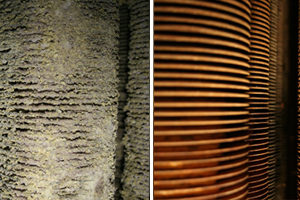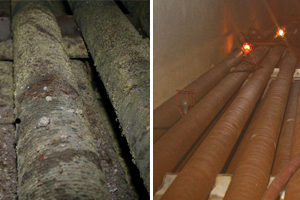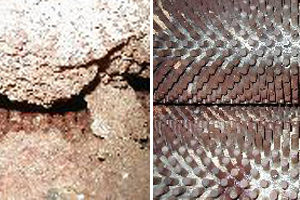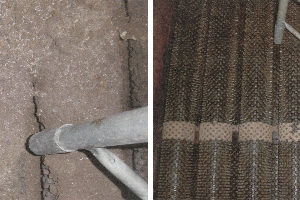Furnace Operation Texas City Texas
Furnace Operation Texas City Texas

Furnace Operation Texas City Texas
Furnace operation Texas City Texas Dry ice, sometimes referred to as “cardice” (chiefly by British chemists), is the solid form of carbon dioxide. It is used primarily as a cooling agent. Its advantages include lower temperature than that of water ice and not leaving any residue (other than incidental frost from moisture in the atmosphere). It is useful for preserving frozen foods where mechanical cooling is unavailable.
Furnace operation Texas City Texas Dry ice sublimates at 194.65 K (−78.5 °C; −109.3 °F), at Earth atmospheric pressures. This extreme cold makes the solid dangerous to handle without protection due to burns caused by freezing (frostbite). While generally not very toxic, the outgassing from it can cause hypercapnia (abnormally elevated carbon dioxide levels in the blood) due to buildup in confined locations. Furnace operation Texas City Texas
Properties Furnace operation Texas City Texas
Furnace operation Texas City Texas Dry ice is the solid form of carbon dioxide (CO2), a molecule consisting of a single carbon atom bonded to two oxygen atoms. Dry ice is colorless, non-flammable, with a sour zesty odor, and can lower the pH of a solution when dissolved in water, forming carbonic acid (H2CO3).
Comparison of phase diagrams of carbon dioxide (red) and water (blue) as a log-lin chart with phase transitions points at 1 atmosphere Furnace operation Texas City Texas
Furnace operation Texas City Texas At pressures below 5.13 atm and temperatures below −56.4 °C (−69.5 °F) (the triple point), CO2 changes from a solid to a gas with no intervening liquid form, through a process called sublimation. The opposite process is called deposition, where CO2 changes from the gas to solid phase (dry ice). At atmospheric pressure, sublimation/deposition occurs at −78.5 °C (−109.3 °F) or 194.65 K. Furnace operation Texas City Texas
The density of dry ice varies, but usually ranges between about 1.4 and 1.6 g/cm (87 and 100 lb/cu ft). The low temperature and direct sublimation to a gas make dry ice an effective coolant, since it is colder than water ice and leaves no residue as it changes state. Its enthalpy of sublimation is 571 kJ/kg (25.2 kJ/mol). Furnace operation Texas City Texas
Dry ice is non-polar, with a dipole moment of zero, so attractive intermolecular van der Waals forces operate. The composition results in low thermal and electrical conductivity. Furnace operation Texas City Texas
History
It is generally accepted that dry ice was first observed in 1835 by French inventor Adrien-Jean-Pierre Thilorier (1790–1844), who published the first account of the substance. In his experiments, it was noted that when opening the lid of a large cylinder containing liquid carbon dioxide, most of the liquid carbon dioxide quickly evaporated. This left the only solid dry ice in the container. In 1924, Thomas B. Slate applied for a US patent to sell dry ice commercially. Subsequently, he became the first to make dry ice successful as an industry. In 1925, this solid form of CO2 was trademarked by the DryIce Corporation of America as “Dry ice”, thus leading to its common name. That same year the DryIce Co. sold the substance commercially for the first time; marketing it for refrigerating purposes. Furnace operation Texas City Texas
The alternative name “Cardice” is a registered trademark of Air Liquide UK Ltd. It is sometimes written as “card ice”. Furnace operation Texas City Texas
Manufacture Furnace operation Texas City Texas
Sublimation of dry ice when placed on the surface of the water at room temperature Furnace operation Texas City Texas
Dry ice is easily manufactured. First, gases with a high concentration of carbon dioxide are produced.  Such gases can be a byproduct of another process, such as producing ammonia from nitrogen and natural gas, oil refinery activities or large-scale fermentation. Second, the carbon dioxide-rich gas is pressurized and refrigerated until it liquefies. Next, the pressure is reduced. When this occurs some liquid carbon dioxide vaporizes, causing a rapid lowering of the temperature of the remaining liquid. As a result, the extreme cold causes the liquid to solidify into a snow-like consistency. Finally, the snow-like solid carbon dioxide is compressed into small pellets or larger blocks of dry ice. Furnace operation Texas City Texas
Such gases can be a byproduct of another process, such as producing ammonia from nitrogen and natural gas, oil refinery activities or large-scale fermentation. Second, the carbon dioxide-rich gas is pressurized and refrigerated until it liquefies. Next, the pressure is reduced. When this occurs some liquid carbon dioxide vaporizes, causing a rapid lowering of the temperature of the remaining liquid. As a result, the extreme cold causes the liquid to solidify into a snow-like consistency. Finally, the snow-like solid carbon dioxide is compressed into small pellets or larger blocks of dry ice. Furnace operation Texas City Texas
A teaching laboratory demonstration for the production of dry ice is to use a 15 lb aluminum carbon dioxide fire extinguisher with a porous fabric collecting bag over the nozzle. The Joule-Thomson expansion of the gas lowers the temperature enough to produce an approximate 50/50 mixture of CO2 gas and dry ice snow also called dust that is collected in the bag. This is an inefficient process, and unsuitable for even lab-scale production. The expansion is inefficient, fire extinguishers are an expensive way to buy carbon dioxide, especially when a signed and dated fire extinguisher certification is required. Furnace operation Texas City Texas
Dry ice is typically produced in three standard forms: large blocks, cylindrical small (5/8 or 1/2 inch diameter) pellets and cylindrical tiny (1/8 inch diameter), high surface to volume pellets that float on oil or water and do not stick to skin because of their high radii of curvature. Tiny dry ice pellets are used primarily for ice blasting, quick freezing, firefighting, oil solidifying and have been found to be safe for experimentation by middle school students wearing appropriate Personal Protective Equipment such as gloves and safety glasses. A standard block weighing approximately 30 kg covered in a taped paper wrapping is most common. These are commonly used in shipping, because they sublime relatively slowly due to a low ratio of surface area to volume. Pellets are around 1 cm (0.4 in) in diameter and can be bagged easily. This form is suited to small-scale use, for example at grocery stores and laboratories where it is stored in a thickly insulated chest. Furnace operation Texas City Texas
Applications Furnace operation Texas City Texas
An ice cream cart Furnace operation Texas City Texas
The most common use of dry ice is to preserve food, using non-cyclic refrigeration.
It is frequently used to package items that must remain cold or frozen, such as ice cream or biological samples, without the use of mechanical cooling. Furnace operation Texas City Texas
Dry ice can be used to flash-freeze food or laboratory biological samples, carbonated beverages, make ice cream, solidify oil spills and stop ice sculptures and ice walls from melting. Furnace operation Texas City Texas
Dry ice can be used to arrest and prevent insect activity in closed containers of grains and grain products, as it displaces oxygen, but does not alter the taste or quality of foods. For the same reason, it can prevent or retard food oils and fats from becoming rancid. Furnace operation Texas City Texas
Sublimation Furnace operation Texas City Texas
Dry ice in water Furnace operation Texas City Texas
When dry ice is placed in water, sublimation accelerated, and slow-sinking, dense clouds of smoke-like fog are created. This is used in fog machines, at theaters, haunted house attractions, and nightclubs for dramatic effects. Unlike most artificial fog machines, in which fog rises like smoke, fog from dry ice hovers near the ground. Dry ice is useful in theater productions that require dense fog effects. The fog originates from the bulk water into which the dry ice is placed, and not from atmospheric water vapor (as is commonly assumed). Furnace operation Texas City Texas
It is occasionally used to freeze and remove warts. However, liquid nitrogen performs better in this role, since it is colder so requires less time to act, and less pressure. Dry ice has fewer problems with storage, since it can be generated from compressed carbon dioxide gas as needed. Furnace operation Texas City Texas
 Plumbers use equipment that forces pressurised liquid CO2 into a jacket around a pipe. The dry ice formed causes the water to freeze, forming an ice plug, allowing them to perform repairs without turning off the water mains. This technique can be used on pipes up to 4 inches (100 mm) in diameter. Furnace operation Texas City Texas
Plumbers use equipment that forces pressurised liquid CO2 into a jacket around a pipe. The dry ice formed causes the water to freeze, forming an ice plug, allowing them to perform repairs without turning off the water mains. This technique can be used on pipes up to 4 inches (100 mm) in diameter. Furnace operation Texas City Texas
Dry ice can be used as bait to trap mosquitoes, bedbugs, and other insects, due to their attraction to carbon dioxide. Furnace operation Texas City Texas
Tiny dry ice pellets can be used to fight fire by both cooling fuel and suffocating the fire by excluding oxygen. Furnace operation Texas City Texas
The extreme temperature of dry ice can cause viscoelastic materials to change to glass phase. Thus it is useful for removing many types of pressure sensitive adhesives. Furnace operation Texas City Texas
Dry ice can be used for loosening asphalt floor tiles or car sound deadening material making it easy to prise off, as well as freezing water in valveless pipes to enable repair. Furnace operation Texas City Texas
One of the largest mechanical uses of dry ice is blast cleaning. Dry ice pellets are shot from a nozzle with compressed air, combining the power of the speed of the pellets with the action of the sublimation. This can remove residues from industrial equipment. Examples of materials removed include ink, glue, oil, paint, mold and rubber. Dry ice blasting can replace sandblasting, steam blasting, water blasting or solvent blasting. The primary environmental residue of dry ice blasting is the sublimed CO2, thus making it a useful technique where residues from other blasting techniques are undesirable. Recently, blast cleaning has been introduced as a method of removing smoke damage from structures after fires. Furnace operation Texas City Texas
Dry ice is also useful for the de-gassing of flammable vapours from storage tanks — the sublimation of dry ice pellets inside an emptied and vented tank causes an outrush of CO2 that carries with it the flammable vapours. Furnace operation Texas City Texas
The removal and fitting of cylinder liners in large engines requires the use of dry ice to chill and thus  shrink the liner so that it freely slides into the engine block. When the liner then warms up, it expands, and the resulting interference fit holds it tightly in place. Similar procedures may be used in fabricating mechanical assemblies with a high resultant strength, replacing the need for pins, keys or welds.
shrink the liner so that it freely slides into the engine block. When the liner then warms up, it expands, and the resulting interference fit holds it tightly in place. Similar procedures may be used in fabricating mechanical assemblies with a high resultant strength, replacing the need for pins, keys or welds.
Dry-ice blasting, a form of carbon dioxide cleaning, is used in a number of industrial applications. Furnace operation Texas City Texas
It is also useful as a cutting fluid. Furnace operation Texas City Texas
Scientific Furnace operation Texas City Texas
In laboratories, a slurry of dry ice in an organic solvent is a useful freezing mixture for cold chemical reactions and for condensing solvents in rotary evaporators. Dry ice/acetone forms a cold bath of −78 °C, which can be used for instance to prevent thermal runaway in a Swern oxidation.
The process of altering cloud precipitation can be done with the use of dry ice. It was widely used in experiments in the US in the 1950s and early 60s before it was replaced by silver iodide. Dry ice has the advantage of being relatively cheap and completely non-toxic. Its main drawback is the need to be delivered directly into the supercooled region of clouds being seeded. Furnace operation Texas City Texas
Call Now: +1-856-678-4004
(Texas City, Texas) (Baton Rouge, Louisiana)
Houston •San Antonio •Dallas •Austin •Fort Worth •El Paso •Arlington •Corpus •Christi •Plano •Laredo •Lubbock •Irving •New Iberia •Luling •West Monroe •Ruston •Thibodaux •Natchitoches •Plaquemine •Abbeville •Leesville •Bastrop •Crowley •Donaldsonville •Franklin •Bogalusa •Minden •Eunic •Baton Rouge •Shreveport •Lafayette •Lake Charles •Opelousas •Morgan City •Monroe

